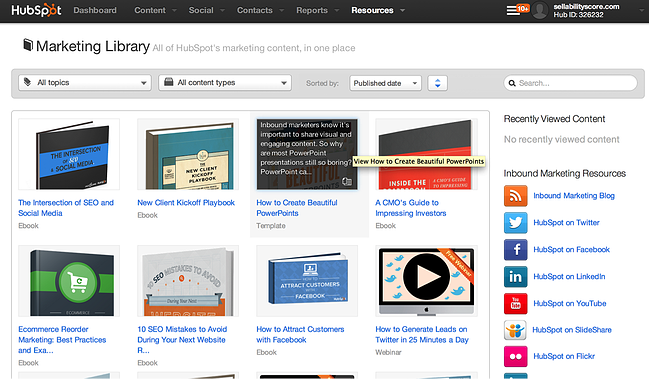Inbound marketing software is to the modern day marketer, what a paint brush is to an artist. An essential tool that is used everyday to build out an elegant finished product.
However, as we all know, just having the tools doesn’t make you successful or talented. Knowing how to utilize the tools in the right way is what separates the beginners from the veterans.
In this blog post, I would like to discuss three reasons why you need to implement inbound marketing software in the “slow season” (If there is such a thing anymore). Although we're in the lazy days of summer (and delaying an inbound integration sounds better left off until the leaves start changing colors), software implementation during downtime is essential to both the success of the roll-out and the sanity of you and your marketing team members. Why? Let's investigate.
1) Time To Learn The Tool
One of the great things about inbound marketing software is how robust and feature rich these applications are. They allow for website and landing page development, email marketing, social media publishing, and blogging to name a few of the most widely used features. This plethora of functionality while exciting and empowering can also be overwhelming for new users.
Most if not all of the most popular inbound marketing platforms on the market have a fairly steep learning curve associated with them. So a purchase and implementation during the “marketing busy season” can cause significant frustration for both the organization and the inbound marketing software vendor. So marketers that do opt for purchasing this software should plan on allocating a significant chunk of time to self-education on their newly purchased software. This is most conveniently done during the slow season.
Additionally, look for the inbound marketing software vendors that have invested in client success resources. By this I mean, weekly training classes on the software, recorded webinars, and best practices guides. These resources will be essential to for two reasons:
- Getting Up to Speed: These resources will help you get up to speed so that you can quickly and effectively start using the software.
- Keeping You Up To Speed: All good software-as-a-service marketing applications are dynamic. Meaning that they adapt and change over time. So these education resources are essential to keep you and your team abreast of the latest functionality changes on the platform
HubSpot is a great example of an organization that is putting significant time, effort, energy and resources into client education and success. Their marketing library continues to grow and expand on a daily basis, and their HubSpot Academy is filled with recorded webinar to help clients expand their knowledge base on things like: blogging, social media promotion, and lead nurturing. It’s these resources that help clients new and old become successful with the HubSpot application.

2) The Need for Content
The second reason that inbound marketing software should be implemented in a slow time is because of the amount of content needed to roll it out effectively. As most marketers know, the central premise of inbound marketing software is delivering highly relevant educational content (blogs, e-books, white-papers, customer case studies, and videos) to prospects and customers over a certain length of time.
Developing this content isn’t a small task, it takes a ton of time, effort, energy, and resources to create. However, without it, there will be nothing for your prospects to: subscribe to, download on your landing pages, or watch on your website.
This content is the fuel that propels inbound marketing and lead generation forward. Recent studies from HubSpot have shown the influence that content has on the bottom line for your business:
- “92% of companies who blogged multiple times a day acquired a customer through their blog.”
- “Companies that blog have 97% more inbound links.”
- “Over 50% of respondents say they read most of their emails”
So smart marketers are doing one of two things:
- Developing Content Beforehand: Marketing teams that know that they will be implementing an inbound marketing software platform are creating content prior to the purchase of the software. This allows them to more quickly plug in the assets they have already developed into the landing pages, and email marketing campaigns that they create on the new platform.
- Developing Content Simultaneously: More realistically marketing teams don’t have the time, resources, and bandwidth to create all the content they need on the front end. Instead these organizations need to carve out time to develop these assets while simultaneously implementing the inbound marketing software.
If this content is not created either beforehand or when the organization is rolling out the software, the implementation will flat out be unsuccessful. At the most basic level, content in all its forms is the fuel that propels inbound marketing software forward. So take time to think through the content development strategy before you go purchasing a software platform.
3) Restructuring Your Digital Presence
The third and final reason that you would want to wait to implement inbound marketing software is because a good marketing software platform will restructure your online presence. Inbound marketing software removes the siloed applications that marketers use to deal with. Instead, these platforms centralize all of marketing functions under one main “umbrella”.
I’m talking about eliminating the website built in Wordpress, the email marketing done through Constant Contact, the blog posted through Blogger, the tweets published through Hootsuite, and analytics reporting done through Google Analytics.
Inbound marketing software systems bring all of these tactical items together. While this is amazing and liberating in so many ways, the flip side of the coin is that much of the information from these previous systems must be ported over to the new inbound marketing software.
This takes time and energy to ensure that essential contact databases, influential blogs posts and search engine authority are moved over. Trying to perform these functions in the heat of the “marketing battle” is going to be difficult if not impossible. So make time to port over the essential assets from your legacy systems during the downtime.
The Bottom Line
In conclusion inbound marketing software is an incredibly powerful tool that can be used to educate prospects, grow your fans and followers, and generate leads for your business. However, the tool itself isn’t the panacea for all marketing and lead generation problems. Instead it’s the software in conjunction with a capable practitioner, great content, and timely campaigns that can help to move the needle from a marketing perspective.
So smart marketing teams allocate time to learn the tools and functionality of the platform, create content to be used in marketing automation campaigns, and port over relevant and information from prior systems. Finally a successful rollout will be one in which team members can spend a significant amount of time working to integrate the tool into their own processes. So find some downtime whether it be in the heart of the summer or around the winter holidays to implement inbound marketing software in your organization.
Originally published Jul 18, 2014 10:00:00 AM, updated January 18 2023
Topics:
Inbound MarketingDon't forget to share this post!
Related Articles
Expand Offer


